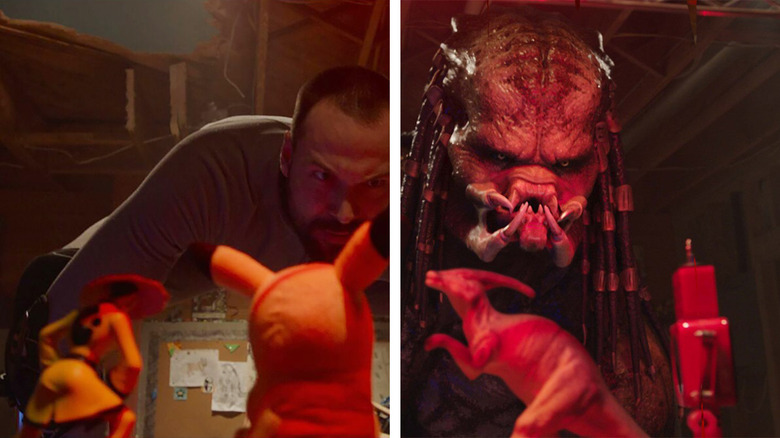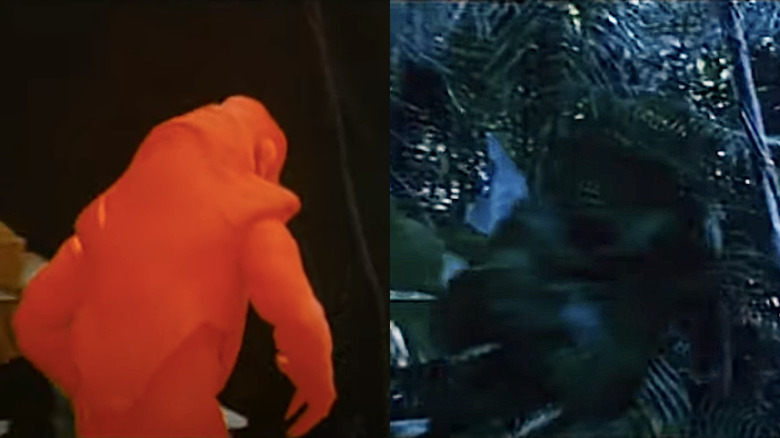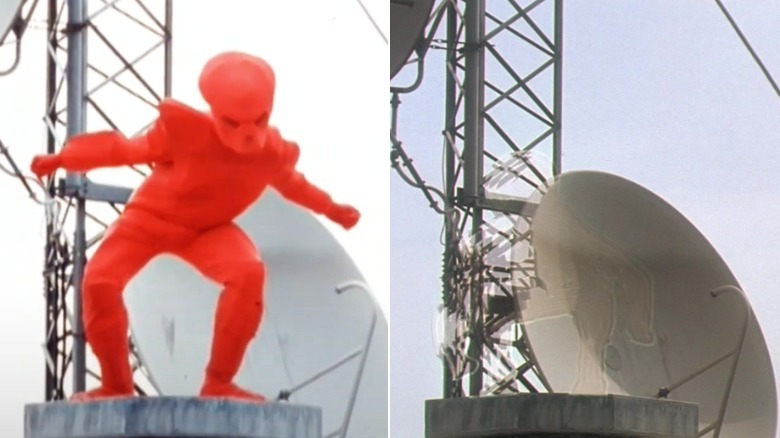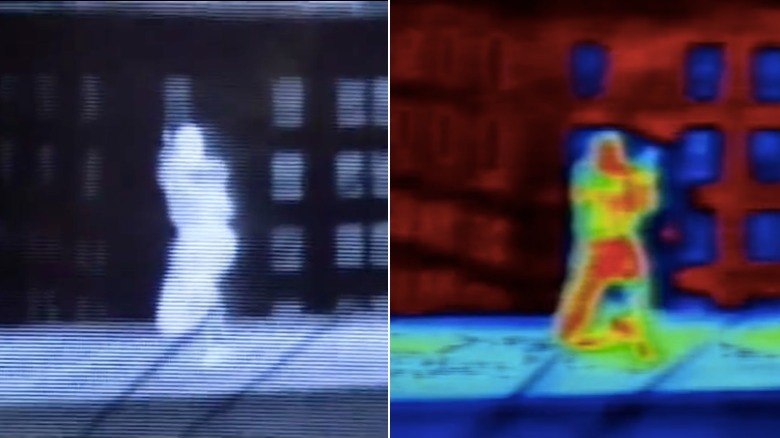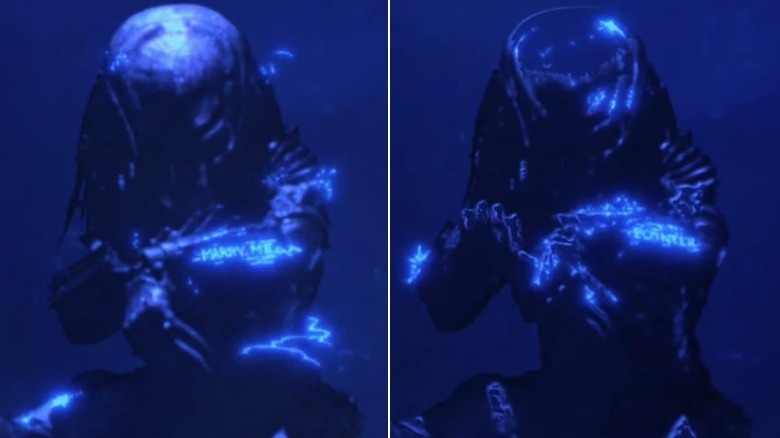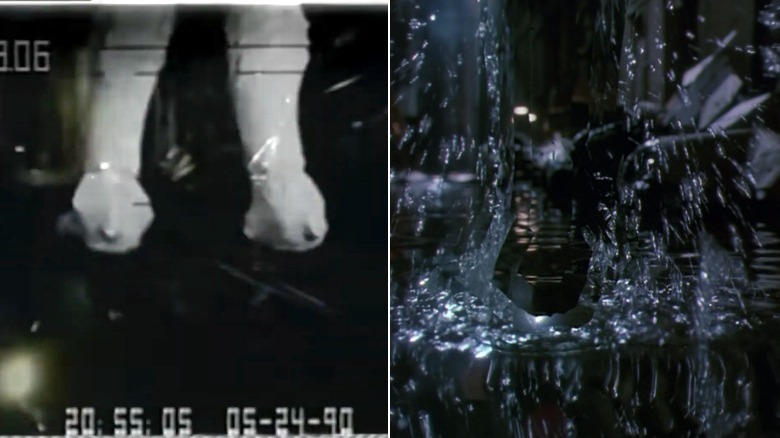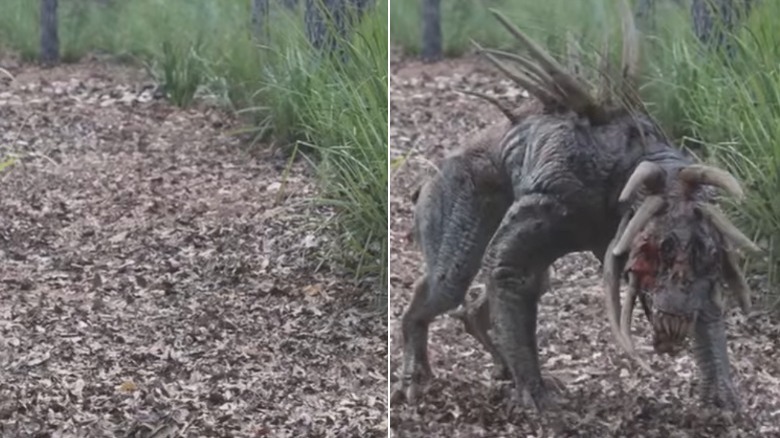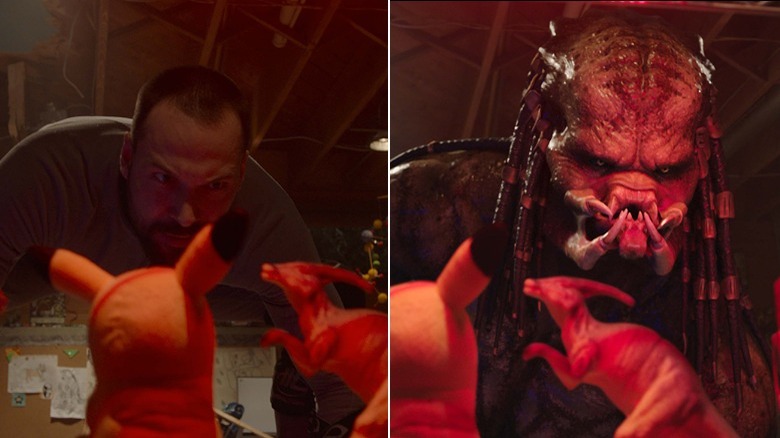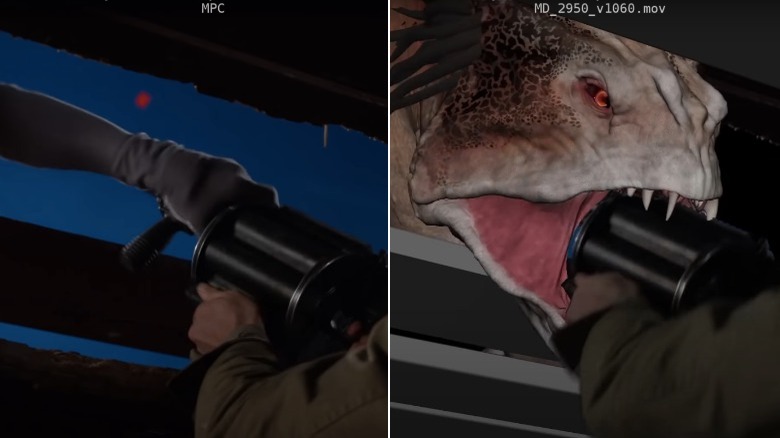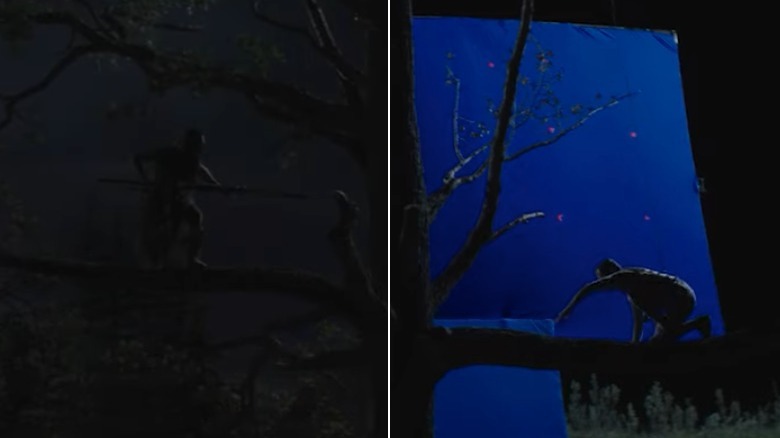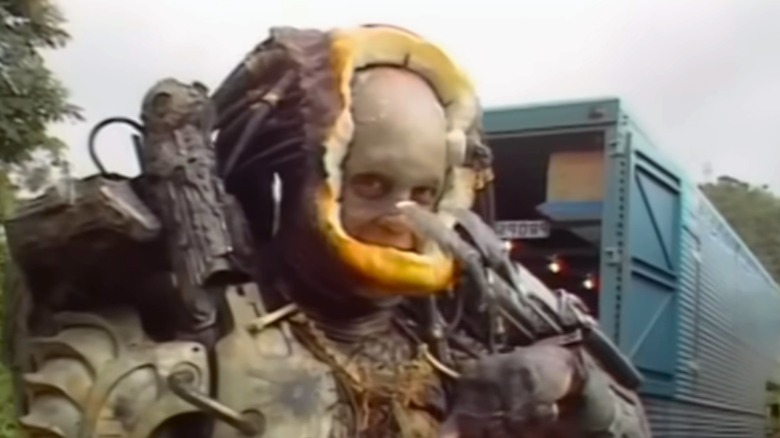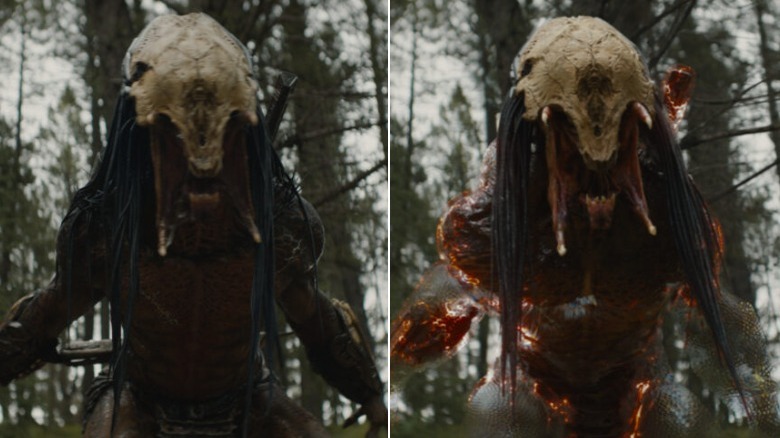What The Predator Movies Look Like Without Special Effects
20th Century Studios (formerly 20th Century Fox) birthed two of the biggest sci-fi horror franchises in history: "Alien" and "Predator." Both were birthed in an age where practical and optical special effects ruled the day, but as sequels, prequels, and crossovers multiplied over the decades, the effects became increasingly digital in nature.
What's surprising is the "Predator" series almost aborted entirely at launch. The original 1987 movie — filmed with the working title "Hunter" — had a troubled production. Money was tight, the titular alien suit proved to be, well, unsuitable, and the production was shut down. Once given a second life, pickup shoots had to fit around star Arnold Schwarzenegger's increasingly busy schedule, and a mad dash to design a replacement title creature resulted in the iconic, dreadlocked, and mandibled design (from the mind of James Cameron) we all know and love to hate.
While the film was a success when the inevitable sequel was put into development, Schwarzenegger was meant to return, but the studio wouldn't agree to his price, and the star dropped out. Franchise producer John Davis told Variety that the issue was a piddling $250K. Minus its iconic human star, the series continued, with four sequels, and two crossover films with the "Alien" franchise.
In the 37 years since the Predator first hit the screen its signature special effects — the thermographic vision, cloak, and Predators themselves — have seen upgrades and evolutions in keeping with the revolution in special effects techniques and technology. Here's a look at what the series looks like without special effects, whether they were practical, optical, or digital.
That Van Dammed Suit
When the original "Predator" was in production, the alien troubling Schwarzenegger and his commandos wasn't Kevin Peter Hall in the iconic Stan Winston Studios' desgn of Predator. Instead, it was not-yet-famous Jean-Claude Van Damme in one of the most infamous unused alternate sci-fi villain designs.
Director John McTiernan was enamored with digitigrade legs, like a bird's. Reportedly under protest, Boss Film built two suits: one fully detailed, another a simple all-red silhouette version for creating optical mattes for the invisibility effect. As feared, the digitigrade legs proved unworkable, and any shot where the creature was seen from head to toe required Van Damme to be suspended from an overhead rig.
Van Damme hated both suits. He especially hated that his martial arts skills were useless in such a getup. With Schwarzenegger's availability running out, the production was shut down, and both Van Damme and Boss Film were fired. Stan Winston was tasked with making a replacement suit, and the film would finish production months later when Schwarzenegger was again available.
But while this buggy Predator 1.0 never made it to our screens, some of the footage of it was useful: R/Greenberg and Associates used footage of that scrapped Red Suit to test various approaches to the cloaking effect. In an unintentionally hilarious clip used as a test (seen here in home video bonus material), someone in that red suit runs past the camera and bounces the alien head off an obstruction. Is it Jean-Claude? Van Dammed if we know.
Big Red
The "Predator" franchise showcases several signature visual effects, with the standout being the weird inline distortion of a Predator's invisibility cloak. A lot of time and effort went into devising a form of invisibility that wasn't truly invisible but rather a distortion of what the creature was moving in front of.
As with the scrapped Van Damme suit, the solution was to create two different versions of the final Predator suit: a full-body hero costume with all the requisite detailing for shots when the creature is visible, and an all-red suit for making the cloak. Normally, red is a terrible color for matte work, as it has the lowest gamma of the primary additive colors. However, given that the creature was to appear against the lush greens of jungle vegetation and the blue of the sky, red was the easiest color to separate from such backgrounds. Whenever the Predator had to be seen but not seen, an actor or stunt performer would wear the red suit for filming.
The effects magicians then pulled mattes on high-contrast film stock to punch a hole in a separately filmed background, and created 5–8 concentric "in-line" mattes through which the background, shot with a wider lens, would be seen at various sizes, like the Fresnel lenses of a lighthouse. The same basic technique was employed for both "Predator" and "Predator 2." These effects were the handiwork of R/Greenberg Associates in New York, famous for creating the flying titles for 1978's "Superman."
Predator Vision
Having evolved in a truly alien environment, the Predator's senses aren't quite the same as ours. It perceives different portions of the electromagnetic spectrum than we do, and its helmet generates infrared images, meaning it displays heat, not visible light. The filmmakers wanted something different from the pseudo-infrared effects employed in "Wolfen" (1981). Infrared film couldn't register body temperature wavelengths, so an Inframetrics thermal video scanner was used. However, the Inframetrics system had only half the vertical resolution of a CRT TV. Worse, for the actors to stand out against the backgrounds, the ambient temperature had to be under 90°F/32°C. The crew lost two days because the jungle set was too hot, resorting to hosing down the vegetation with refrigerated water when the weather was uncooperative.
VFX supervisor Joel Hynek told VFXBlog.com that because pure thermography can be somewhat unclear, Predator vision was simultaneously photographed by both thermal and motion picture cameras using a "beam splitter," or a half-silvered mirror. The setup was rigged on a Steadicam, linked to the Inframetrics encoders by hundreds of feet of cable. The two monochromatic images were combined on video and colors were assigned to each shade, yielding a coherent image. The inherent differences between cameras didn't yield perfect image registration, but it was close enough for the effect to work.
For the Predator's POV sans helmet, the film camera footage was processed using a solarization process, so it still looked alien but distinct from the thermal view.
Electrifying engagement
In any scene with energy sparking off a Predator's cloak as it activates, deactivates, or malfunctions, any frame where the sparking is off ably demonstrates what the footage looks like minus the effect. So instead of a before-and-after comparison, consider these two frames from the same scene, in which the animation features an in-joke. Look carefully at the sparks on the gauntlet on the Predator's left arm. The words "marry me" are followed by "Poynter".
That's the name of animator Donald Poynter, who did effects animation in both "Predator" and "Predator 2." In the Joel Hynek interview mentioned above, he says, "There's one frame in there where he claims he spelled out his name in electricity on the Predator. I can't say I've ever found it." Well, a fan named H.T. Fenik found it in "Predator 2." As related in a video on Fenik's YouTube channel, when another fan reached out to the animator, he confirmed the gag as being executed around the time he proposed to his wife and claimed he'd hidden his name in all but one of the effects animation shots he'd worked on. Seriously, jump to 1:16:56 in the film. Go slow-mo and see for yourself.
In the pre-digital age of the first two films, such animations were drawn in pencil on pin-registered animation paper. The black-on-white drawings were then photographed to produce mattes and composited and tinted by the optical crew. Did they see the joke? Who knows?
Splishing and splashing
As mentioned above, successfully integrating creatures realized using visual effect trickery into live-action settings works best when the illusion of interaction is achieved. The more complex the interaction, the better. Digital tools make this easier now, but one particularly challenging scene in "Predator 2" was the moment when a cloaked Predator drops into a wet alley and strides through the water toward villainous King Willie, prior to killing him.
This scenario is simple enough with a visible being, but an invisible one? That requires showing the effect of footsteps in the water while also depicting the distortion of the cloak. The usual red suit cloaking trick wouldn't work because the splashes would be obscured by the suit itself.
The solution involved rigging tubes through which compressed air would be fired each place the cloaked menace stepped. A motion control camera was used to move along the alley with the compressed air triggering splashes. Another pass was made with a man in an all-white suit wrapped in clear plastic, walking carefully so his feet hit the splash spots at the same timing. When combined with the in-line matte technique to create the distortion, it made for an almost entirely convincing effect.
I say "almost," because the one thing this technique could not do was leave footprints in the water where the feet presumably displaced it.
A pack of trouble
While the Predators were largely portrayed using men in suits, the fauna seen on the alien world in "Predators" required a different technique. Working with animals on a film set is always risky in terms of achieving a convincing performance, especially for hostile creatures. Putting actual animals into heavy makeup or other costumes is fraught for several reasons, not least of which is the potential to harm them. So the hostile life forms on the planet had to be created entirely with special and visual effects.
When a pack of the Predators' preposterously horned quadrupedal "Hellhounds" attacks the party, they are primarily realized with CGI, animated, and tracked into live-action location photography. CGI plants, soil, and dust are animated to convincingly integrate them with the environment, as seen in Hybride's VFX reel. They also had to be highly destructible. "The humans use machine guns and shotguns to kill them so we had to create models of the Hounds half-destroyed with limbs missing and bullet holes in their heads or horns shattered," Philippe Théroux, lead CG supervisor for Hybride, told AWN.
An animatronic puppet was also built for closeup interaction with the cast, as when one of the beasts leaps atop one member of the party, though you can see that the horn he grabs onto is kinda flaccid and wiggles around during his struggle to stay alive.
Upgrades
As the original "Jurassic Park" ably demonstrated, the most convincing illusions are often accomplished with multiple techniques combined in a single scene. That film intercut between two different animatronic T-Rexes (including one that wasn't waterproof) and a fully CGI version depending on the needs of a given shot. It likewise switched between human-powered, animatronic and CGI raptors.
A similar approach was employed in "The Predator." The titular foe (portrayed by Brian Prince) is largely an animatronic suit, but in some shots, it is either enhanced or fully replaced by a CGI version.
In its brief and fatal battle with the colossal "Upgrade" Predator (played by T.J. Storm and others), its opponent is a wholly CGI creation by MPC Film's Character Lab. The sheer size of this creature made it impractical to execute using a suit or even a large animatronic, though a full-size bust was used on set for lighting reference. Much of its performance was driven by humans in mocap suits, who provided on-camera references for animators and interacted with on-set elements, and then brought to life by MPC's animation team.
A bellyfull of dead
A one-and-done addition to the franchise is the heavily muscled and armored Predator Dogs featured in "The Predator." These animals look fundamentally different from the horn-covered Hellhounds seen in "Predators," and like the Upgrade, feature armored hides and bad dispositions. They're effectively bulletproof, shrugging off numerous hits, and even being hit by a car. But they're not invincible. One chomps down on the business end of a grenade launcher and gets a bellyful of grenade for its trouble, causing it to messily explode. The concussion of a point-blank gunshot to the temple lobotomizes the other and makes it friendly to humans.
As seen in a behind-the-scenes video from 20th Century Fox, the dogs are fully CGI creations and were represented on set by people in mocap suits, employing crutches to give them a bent-over posture. The goofy performance of the mocap actor playing the friendly dog demonstrates how seriously these people take their craft. However, the mocap actor playing the doomed dog just grabs the grenade launcher with his hand instead of his mouth, so you have to wonder how committed he was to the role.
With all this digital fakery what might surprise you is that almost the entire sports field setting was created in post-production.
Up a tree
While 2022's "Prey"'s direct-to-streaming release strategy was a mistake, it quickly became the best-reviewed entry in the franchise, hands down. Setting it in 18th-century North America and making its protagonists Native Americans bereft of modern weaponry grounds the film in ways its predecessors never managed and puts a new spin on the predator and prey dynamics of the series.
Unlike "Predators" with its alien fauna and "The Predator" with its Predator dogs, "Prey" limits its fantastical creatures to one: the Predator. Every other animal is of the earthly variety, and perhaps even scarier than the otherworldly ones because they are more convincing. Primary visual supplier MPC film created all such CGI fauna.
When the mountain lion (which sounds nothing like a real one) leaps into the tree where Naru is perched, actor Amber Midthunder faces not a big cat but a man in a mocap suit, giving her something to react to. Both were photographed in front of a bluescreen, so much of the background was added digitally as well. The animation team based the animal movements on reference footage of their real-life counterparts to capture their mass and movements, and the simulation teams added muscle and fur dynamics. The big battle between the Predator and the Grizzly also required water and blood simulations, which had to flow over the cloaking effect to give Naru a horrifying hint of what this creature looks like.
The Biggest Effect
The biggest, and I mean biggest, effect in all the series' entries is the Predators themselves. These big, heavy full-body animatronic-enhanced costumes are practical effects and works of cinematic art. They look almost as fantastic in person as they do on screen — I know, having once been up close and personal with an actual "Predator 2" suit.
But the suits weren't always complete. Depending on the framing of a given shot, sometimes the actors didn't wear the head or wore only a partial head that left their face exposed, and these partial heads were used when a Predator's helmet was on. Minus the head or helmet, the illusion is shattered, and we see the Predator for what it is: an elaborate actor-driven effect.
The man in the original Predator costume was the towering Kevin Peter Hall, who had previously played the titular role of the lovable sasquatch in "Harry and the Hendersons." While the Predator suit was heavy, hot, uncomfortable, and confining, in a behind-the-scenes video, Stan Winston said Hall rarely complained and never delayed a shot because he couldn't stand being in the suit. Hall said, "Stan creates the outside and then I'm like the spark. You know, like the life that's inside. Without that, you know, you have...a suit." And that's why putting human beings, especially actors, in these costumes is essential to getting a performance out of these towering effects. Without their performance, it's just a puppet.
Predator enhancements
Throughout the series, the Predators have largely been realized as they were from the get-go: large men in intricate costumes. Always, there's a man there at the center of the show. This remains so in "Prey," where the Predator is portrayed by American actor and former basketball player Dane DiLiegro in a Studio ADI animatronic suit.
However, increasingly, even practical effects are being sweetened digitally in post-production, with CGI augmenting or replacing parts of the practical costumes. This is especially useful for getting complex facial movements that the animatronics can't execute or movements the suits or a human body can't physically achieve. In such cases, a full CGI Predator was used all or in part. The CGI version was also used in place of the old red suit technique for the cloak effects, allowing for more complex visual interactions with the environments, such as when the Grizzly's blood pours over the invisible Predator's form.
In an age where studios and filmmakers bend over backwards to claim they are using practical effects and not CGI (looking at you, "Top Gun: Maverick" and "Barbie"), even though they are merely using less obvious visual effects, the mixture of digital and practical is probably the best of both worlds, even if we secretly yearn for some of those old red suit cloak effects.
With a new Predator movie coming, and more in the works, it'll be fascinating to see what those look like, with and without special effects.
